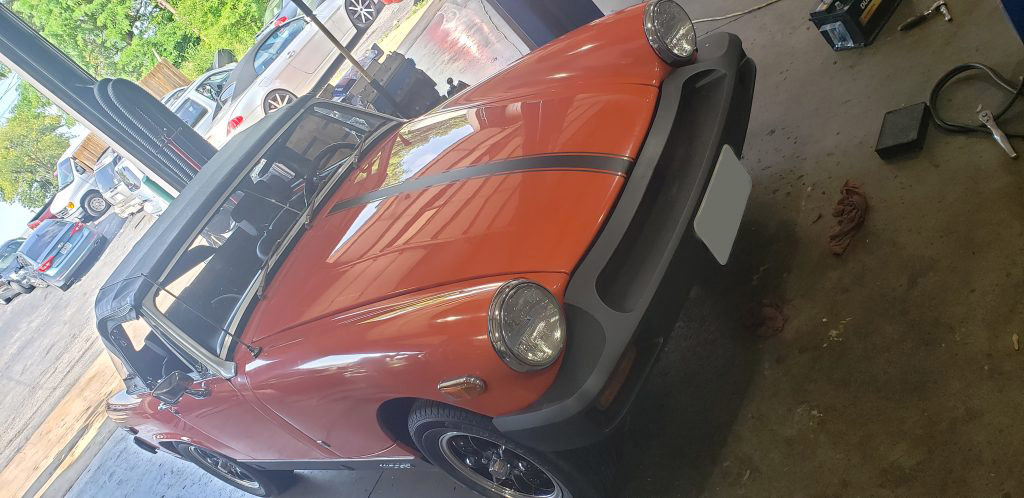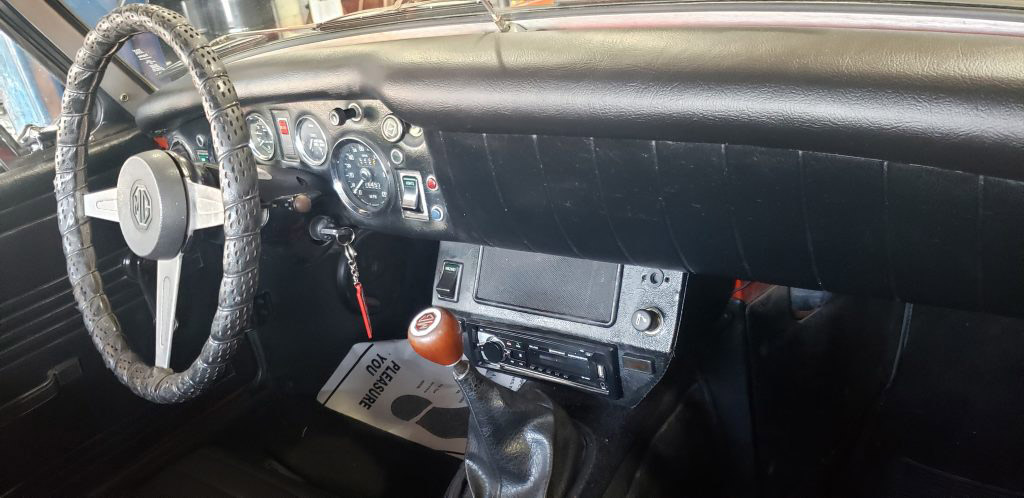Sometimes, here at Hillside Auto Repair, we see some amazing cars! Just this week one of them rolled into our garage. A lovely MG Midget!

Exterior

Interior
Some History of the Midget (thank you Wikipedia!)
The MG Midget is a small two-seater sports car produced by MG from 1961 to 1979. It revived a name that had been used on earlier models such as the MG M-type, MG D-type, MG J-type and MG T-type.
The first version, announced at the end of June 1961, was essentially a slightly more expensive badge-engineered version of the MkII Austin-Healey Sprite deluxe version. The original ‘frogeye’ Sprite had been introduced specifically to fill the gap in the market left by the end of production of the MG T-type Midget as its replacement, the MGA had been a significantly larger and more expensive car with greater performance. Many existing MG buyers turned to the Sprite to provide a modern low-cost sports car and so a badge-engineered MG version reusing the Midget name made sense. The new Midget differed from the Sprite only in grille design, badging, improved interior trim, better instruments and added external polished trim to justify its higher price.
Mechanically the car was identical to its Austin-Healey counterpart, retaining the rear suspension using quarter-elliptic leaf springs and trailing arms from the ‘frogeye’. The engine was a 948 cc A-Series with twin SU carburettors producing 46 hp (34 kW) at 5500 rpm and 53 lb⋅ft (72 N⋅m) at 3000 rpm. Brakes were 7-inch (178 mm) drums all round. A hard top, heater, radio and luggage rack were available as factory-fitted extras.
In October 1962, the engine was increased to 1098 cc, raising the output to 56 hp (42 kW) at 5500 rpm and 62 lb⋅ft (84 N⋅m) at 3250 rpm, and disc brakes replaced the drums at the front. 13×4″ Wire spoked wheels became available.
The doors had no external handles or locks and the windows were sliding Perspex side-screens. A heater was an optional extra.
Production was 16,080 of the small-engined version and 9601 of the 1098.
A car with the 948 cc engine was tested by the British magazine The Motor in 1962 and had a top speed of 87.9 mph (141.5 km/h) and could accelerate from 0-60 mph (97 km/h) in 18.3 seconds. A fuel consumption of 40.2 miles per imperial gallon (7.03 L/100 km; 33.5 mpg‑US) was recorded. The test car cost £689 including taxes on the UK market.
Externally the main changes were to the doors, which gained wind-up windows, swivelling quarter lights (AKA wing windows), external handles, and separate locks. The windscreen gained a slight curvature and was retained in a more substantial frame. The hood (US – top), though modified, continued to have a removable frame that had to be erected before the cover was put on. The rear springs were replaced by more conventional semi-elliptic types, which gave a better ride. The engine block was strengthened and larger main bearings were fitted, increasing the power to 59 hp (44 kW) at 5750 rpm and torque to 65 lb⋅ft (88 N⋅m) at 3500 rpm.
A total of 26,601 were made.
1970’s Changes
In August 1971, the compression ratio on North American engines was reduced to 8.0:1. Engine power output fell to 54.5 bhp (40.6 kW) at 5500 rpm and 67 lb⋅ft (91 N⋅m) at 3250 rpm.
The square-shaped rear wheel arches became rounded in January 1972. Also in this year, a Triumph steering rack was fitted, giving a gearing that was somewhat lower than earlier Midgets. A second exhaust silencer was also added in 1972. Alternators were fitted instead of dynamos (generators) from 1973 onwards.
Seven months into the 1974 model year, oversized rubber bumper blocks, nicknamed “Sabrinas” after the well-endowed British actress, were added to the chrome bumpers to meet the first US bumper impact regulations.
Many consider the round-arch Midgets with chrome bumpers produced for model years 1972-1974 to be the most desirable. These round-arch cars started leaving the Abingdon factory in late 1971. Between 1966 and the 1969 face lift, 22,415 were made, and a further 77,831 up to 1974.
To meet US federal regulations, large black plastic bumpers were added to the front and rear and the ride heights were increased. The increased ride heights affected handling, and anti-roll bars were added to help with the higher centre of gravity. The A-Series engine was replaced by the 1493 cc Standard SC engine from the Triumph Spitfire, coupled to a modified Morris Marina gearbox with synchromesh on all four gears. The increased displacement of the new engine was better able to cope with the increasing emission regulations. Although the horsepower ratings were similar (65 bhp – home market) the 1493 cc engine produced more torque. The increased output combined with taller gear ratios resulted in faster acceleration (12 seconds 0–60 compared to 13 for the 1275 cc version) and top speed of just over 100 mph. In the US market British Leyland struggled to keep engine power at acceptable levels, as the engines were loaded with air pumps, EGR valves and catalytic converters to keep up with new US and California exhaust emission control regulations.
Home market cars had twin SU HS4 carbs The U.S market’s dual SU HS2 carbs were swapped for a single Zenith-Stromberg 150 CD4 unit catalytic converter carb in 1976 and all models after came with the Zenith-Stromberg 150 CD4T [7] and the power fell to 50 bhp at 5000 RPM and 67 lb-ft of torque at 2500 RPM. The round rear-wheel arches were now square again, to increase the body strength. The last car was made on 7 December 1979, after 73,899 of the last version had been made. The last 500 home-market cars were painted black.